A Fractional-Order Creep Model of Water-Immersed Coal
Abstract
:1. Introduction
2. Experimental Methods
2.1. Specimen Preparation
2.2. Structural Observation of Immersed Coal
2.3. Experimental Facilities
2.4. Results of Creep Deformation
3. Evolution of Creep Performance
3.1. Evolution of Elastoplastic Properties

3.2. Evolution of Creep Rate
3.2.1. Steady Creep Rate
3.2.2. Accelerated Creep Rate
4. Fractional-Order-Based Creep Model
4.1. One-Dimensional Fractional-Order Creep Model
4.2. Validation of Creep Damage Model Parameters
5. Conclusions
- (1)
- Water-immersion time has a significant influence on the elastoplastic performance of coal, exhibiting the longer water-immersion time, the lower elastic modulus and strength, and the degradation of the elastic modulus and strength, which is nonlinear to the increment of the water-immersion time.
- (2)
- Both the stress level and water-immersion time reduce the elastic viscosity and plastic viscosity of coal with a slightly nonlinear relationship, thereby increasing its creep rate. Such a promoting effect is limited when the water-immersion time reaches to a certain period.
- (3)
- A fractional-order derivative-based creep model was constructed to meet the deformation law of coal under the conditions of the variable stress level and water-immersion time. A verification of the creep model associated with the creep experiment suggests good agreement with the experiment curves, the stress levels, and the water-immersion time, showing the controlling role of the creep deformation of coal. It can well reflect the creep characteristics of the water-immersed coal at each stage of the stress levels.
Author Contributions
Funding
Institutional Review Board Statement
Informed Consent Statement
Data Availability Statement
Conflicts of Interest
References
- Xie, H.; Zhao, J.; Zhou, H.; Ren, S.; Zhang, R. Secondary utilizations and perspectives of mined underground space. Tunn. Undergr. Space Technol. 2020, 96, 103129. [Google Scholar] [CrossRef]
- Guo, P.; Wang, M.; Dang, G.; Zhu, T.; Wang, J.; He, M. Evaluation method of underground water storage space and thermal reservoir model in abandoned mine. Rock Mech. Bull. 2023, 2, 100044. [Google Scholar] [CrossRef]
- Liu, F.; Li, S. Discussion on the new development and utilization of underground space resources of transitional coal mines. J. China Coal Soc. 2017, 42, 2205–2213. [Google Scholar]
- Yong, X.; Chen, W.; Wu, Y.; Tao, Y.; Zhou, J.; He, J. A two-stage framework for site selection of underground pumped storage power stations using abandoned coal mines based on multi-criteria decision-making method: An empirical study in China. Energy Convers. Manag. 2022, 260, 115608. [Google Scholar] [CrossRef]
- Xie, H.; Xu, W.; Liu, C.; Yang, X. The subversive idea and key technical prospects on underground hydraulic engineering. Chin. J. Rock Mech. Eng. 2018, 37, 781–791. [Google Scholar]
- Qian, R.; Feng, G.; Guo, J.; Wang, P.; Jiang, H. Effects of water-soaking height on the deformation and failure of coal in uniaxial compression. Appl. Sci. 2019, 9, 4370. [Google Scholar] [CrossRef]
- Wang, K.; Feng, G.; Bai, J.; Guo, J.; Shi, X.; Cui, B.; Song, C. Dynamic behaviour and failure mechanism of coal subjected to coupled water-static-dynamic loads. Soil Dyn. Earthq. Eng. 2022, 153, 107084. [Google Scholar] [CrossRef]
- Fan, J.; Li, Z.; Feng, G.; Zhang, H.; Qi, C.; Zhang, J. Failure analysis of coal pillars and overburden from underground water reservoir under the mining-water invasion coupling effect. Eng. Fail. Anal. 2023, 151, 107406. [Google Scholar] [CrossRef]
- Menéndez, J.; Schmidt, F.; Konietzky, H.; Fernández-Oro, J.M.; Galdo, M.; Loredo, J.; Díaz-Aguado, M.B. Stability analysis of the underground infrastructure for pumped storage hydropower plants in closed coal mines. Tunn. Undergr. Space Technol. 2019, 94, 103117. [Google Scholar] [CrossRef]
- Colas, E.; Klopries, E.M.; Tian, D.; Kroll, M.; Selzner, M.; Bruecker, C.; Khaledi, K.; Kukla, P.; Preuße, A.; Sabarny, C.; et al. Overview of converting abandoned coal mines to underground pumped storage systems: Focus on the underground reservoir. J. Energy Storage 2023, 73, 109153. [Google Scholar] [CrossRef]
- Zhang, C.; Wang, X.; Han, P.; Bai, Q.; Chen, J. Failure analysis of residual coal pillar under the coupling of mining stress and water immersion in the goaf underground water reservoir. Environ. Earth Sci. 2023, 82, 309. [Google Scholar] [CrossRef]
- Bruno, G.; Tupputi, D.; Simeone, V. Geomechanical modelling and stability analysis of the shallow underground water reservoir ‘Palombaro Lungo’(Matera-Italy). Environ. Earth Sci. 2023, 82, 302. [Google Scholar] [CrossRef]
- Zhang, C.; Wang, F.; Bai, Q. Underground space utilization of coalmines in China: A review of underground water reservoir construction. Tunn. Undergr. Space Technol. 2021, 107, 103657. [Google Scholar] [CrossRef]
- Lyu, X.; Chi, X.; Yang, K.; Yuan, L.; Fang, J.; Zhang, Z. Strength modeling and experimental study of coal pillar-artificial dam combination after wetting cycles. J. Mater. Res. Technol. 2023, 25, 3050–3060. [Google Scholar] [CrossRef]
- Ju, J.; Li, Q.; Xu, J.; Wang, X.; Lou, J. Self-healing effect of water-conducting fractures due to water-rock interactions in undermined rock strata and its mechanisms. Bull. Eng. Geol. Environ. 2020, 79, 287–297. [Google Scholar] [CrossRef]
- Liu, Q.; Sun, Y.; Li, J. Experimental study on seepage characteristics of Jurassic weakly cemented sandstone under water-rock interaction. Geofluids 2020, 2020, 8543687. [Google Scholar] [CrossRef]
- Yao, Q.; Chen, T.; Tang, C.; Sedighi, M.; Wang, S.; Huang, Q. Influence of moisture on crack propagation in coal and its failure modes. Eng. Geol. 2019, 258, 105156. [Google Scholar] [CrossRef]
- Depeng, M.; Yan, Z.; Chuanxiao, L. Creep behavior and acoustic emission characteristics of coal samples with different moisture content. Acta Geodyn. Geomater. 2018, 15, 405–412. [Google Scholar]
- Chen, G.; Li, T.; Yang, L.; Zhang, G.; Lyu, P.; Teng, P. Mechanical properties and damage characteristics of coal-rock combined samples under water-rock interaction. Coal Sci. Technol. 2023, 51, 37–46. [Google Scholar] [CrossRef]
- Song, H.; Zhong, Z.; Lin, B. Mechanical degradation model of porous coal with water intrusion. Energy 2023, 278, 127786. [Google Scholar] [CrossRef]
- Yao, Q.; Chen, T.; Ju, M.; Liang, S.; Liu, Y.; Li, X. Effects of water intrusion on mechanical properties of and crack propagation in coal. Rock Mech. Rock Eng. 2016, 49, 4699–4709. [Google Scholar] [CrossRef]
- Liu, Y.; Liu, C.; Kang, Y.; Wang, D.; Ye, D. Experimental research on creep properties of limestone under fluid–solid coupling. Environ. Earth Sci. 2015, 73, 7011–7018. [Google Scholar] [CrossRef]
- Wang, Z.; Li, B.; Ren, C.; Li, J.; Cheng, Q.; Wu, X.; Yao, C. Energy-Driven Damage Constitutive Model of Water-Bearing Coal Under Triaxial Compression. Rock Mech. Rock Eng. 2023, 1–20. [Google Scholar] [CrossRef]
- Yi, S.; Zhang, Y.; Yi, H.; Li, X.; Wang, X.; Wang, Y.; Chu, T. Study on the instability activation mechanism and deformation law of surrounding rock affected by water immersion in goafs. Water 2022, 14, 3250. [Google Scholar] [CrossRef]
- Yu, C.; Tang, S.; Tang, C.; Duan, D.; Zhang, Y.; Liang, Z.; Ma, K.; Ma, T. The effect of water on the creep behavior of red sandstone. Eng. Geol. 2019, 253, 64–74. [Google Scholar] [CrossRef]
- Gao, Y.; Wei, W.; Hua, D.; Jiang, Q. Study on creep characteristics of mudstone with different initial water contents in soaking conditions and its engineering applications. Bull. Eng. Geol. Environ. 2022, 81, 380. [Google Scholar] [CrossRef]
- Zhou, H.; Wang, C.; Han, B.; Duan, Z. A creep constitutive model for salt rock based on fractional derivatives. Int. J. Rock Mech. Min. Sci. 2011, 48, 116–121. [Google Scholar] [CrossRef]
- Lyu, C.; Liu, J.; Ren, Y.; Liang, C.; Liao, Y. Study on very long-term creep tests and nonlinear creep-damage constitutive model of salt rock. Int. J. Rock Mech. Min. Sci. 2021, 146, 104873. [Google Scholar] [CrossRef]
- Yang, C.; Daemen, J.; Yin, J.H. Experimental investigation of creep behavior of salt rock. Int. J. Rock Mech. Min. Sci. 1999, 36, 233–242. [Google Scholar] [CrossRef]
- Kamdem, T.C.; Richard, K.G.; Béda, T. New description of the mechanical creep response of rocks by fractional derivative theory. Appl. Math. Model. 2022, 116, 624–635. [Google Scholar] [CrossRef]
- Nishihara, M. Creep of shale and sandy-shale. J. Geol. Soc. Jpn. 1952, 58, 373–377. [Google Scholar] [CrossRef]
- Feng, Y.Y.; Yang, X.J.; Liu, J.G.; Chen, Z.Q. A new fractional Nishihara-type model with creep damage considering thermal effect. Eng. Fract. Mech. 2021, 242, 107451. [Google Scholar] [CrossRef]
- Wu, F.; Liu, J.F.; Wang, J. An improved Maxwell creep model for rock based on variable-order fractional derivatives. Environ. Earth Sci. 2015, 73, 6965–6971. [Google Scholar] [CrossRef]
- Huang, P.; Zhang, J.; Damascene, N.J.; Dong, C.; Wang, Z. A fractional order viscoelastic-plastic creep model for coal sample considering initial damage accumulation. Alex. Eng. J. 2021, 60, 3921–3930. [Google Scholar] [CrossRef]
- Hou, R.; Zhang, K.; Tao, J.; Xue, X.; Chen, Y. A nonlinear creep damage coupled model for rock considering the effect of initial damage. Rock Mech. Rock Eng. 2019, 52, 1275–1285. [Google Scholar] [CrossRef]
- Zhou, H.; Wang, C.; Mishnaevsky, L.; Duan, Z.; Ding, J. A fractional derivative approach to full creep regions in salt rock. Mech. Time-Depend. Mater. 2013, 17, 413–425. [Google Scholar] [CrossRef]
- Zhang, L.; Zhou, H.; Wang, X.; Wang, L.; Su, T.; Wei, Q.; Deng, T. A triaxial creep model for deep coal considering temperature effect based on fractional derivative. Acta Geotech. 2022, 17, 1739–1751. [Google Scholar] [CrossRef]
- Deng, H.; Zhou, H.; Li, L. Fractional creep model of temperature-stress-time coupled damage for deep coal based on temperature-equivalent stress. Results Phys. 2022, 39, 105765. [Google Scholar] [CrossRef]
- Yu, L.; Yao, Q.; Chong, Z.; Li, Y.; Xu, Q.; Liu, Z. Experimental study on the moisture migration and triaxial mechanical damage mechanisms of water-bearing coal samples. Int. J. Rock Mech. Min. Sci. 2022, 160, 105263. [Google Scholar] [CrossRef]
- Guo, J.; Zhang, T.; Pan, H.; Wu, J. Experimental investigation of the creep damage evolution of coal rock around gas extraction boreholes at different water contents. PLoS ONE 2023, 18, e0278783. [Google Scholar] [CrossRef]
- Ji, Z.; Jiang, P.; Yi, H.; Zhuo, Z.; Li, C.; Wu, Z. Application of two novel acoustic emission parameters on identifying the instability of granite. Entropy 2022, 24, 750. [Google Scholar] [CrossRef] [PubMed]
- Chanard, K.; Nicolas, A.; Hatano, T.; Petrelis, F.; Latour, S.; Vinciguerra, S.; Schubnel, A. Sensitivity of acoustic emission triggering to small pore pressure cycling perturbations during brittle creep. Geophys. Res. Lett. 2019, 46, 7414–7423. [Google Scholar] [CrossRef]
- Xu, T.; Zhou, G.; Heap, M.J.; Yang, S.; Konietzky, H.; Baud, P. The modeling of time-dependent deformation and fracturing of brittle rocks under varying confining and pore pressures. Rock Mech. Rock Eng. 2018, 51, 3241–3263. [Google Scholar] [CrossRef]
- Yu, L.; Yao, Q.; Chong, Z.; Li, Y.; Xu, Q.; Xie, H.; Ye, P. Mechanical and micro-structural damage mechanisms of coal samples treated with dry–wet cycles. Eng. Geol. 2022, 304, 106637. [Google Scholar] [CrossRef]
- Khalil, R.; Al Horani, M.; Yousef, A.; Sababheh, M. A new definition of fractional derivative. J. Comput. Appl. Math. 2014, 264, 65–70. [Google Scholar] [CrossRef]
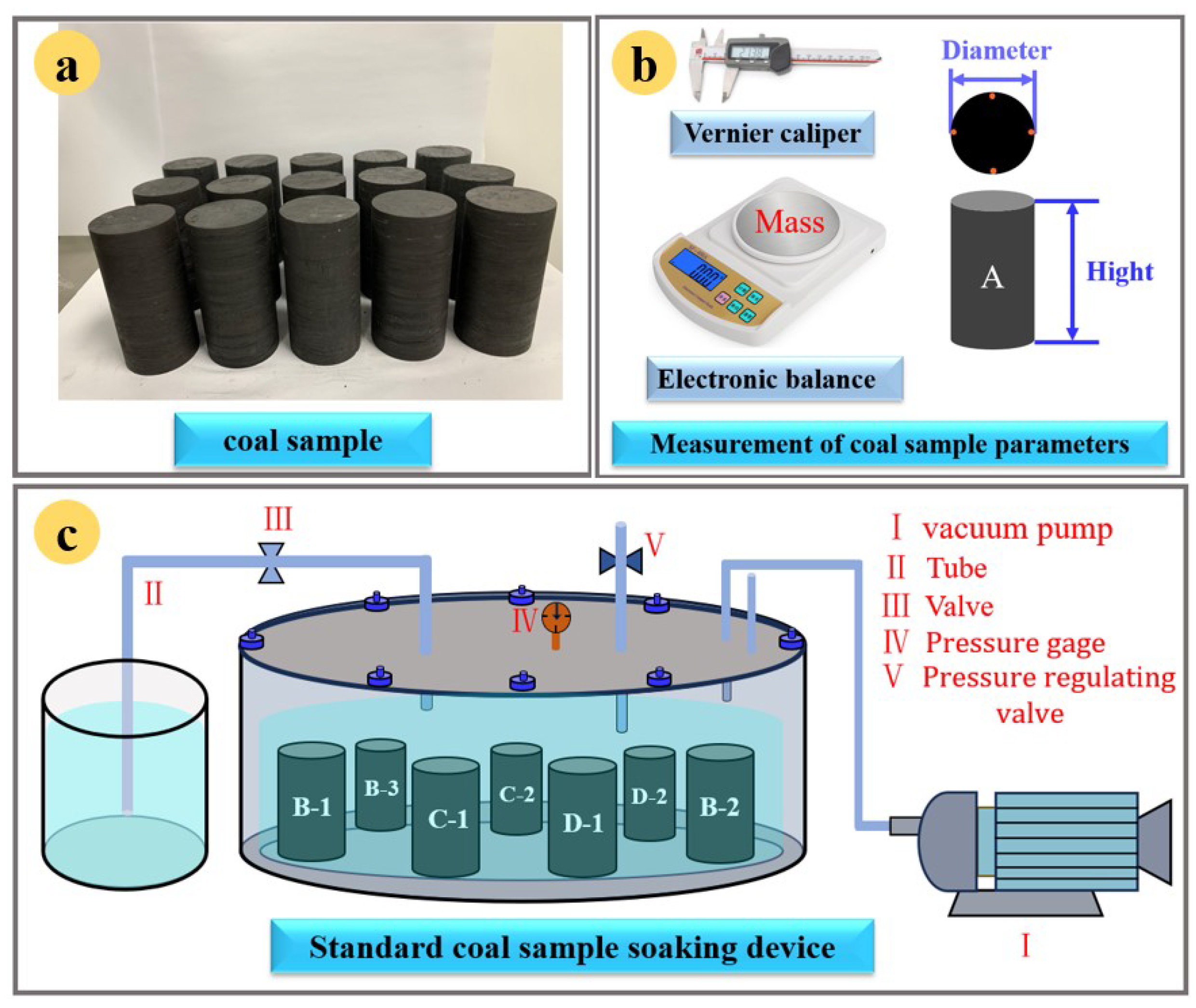
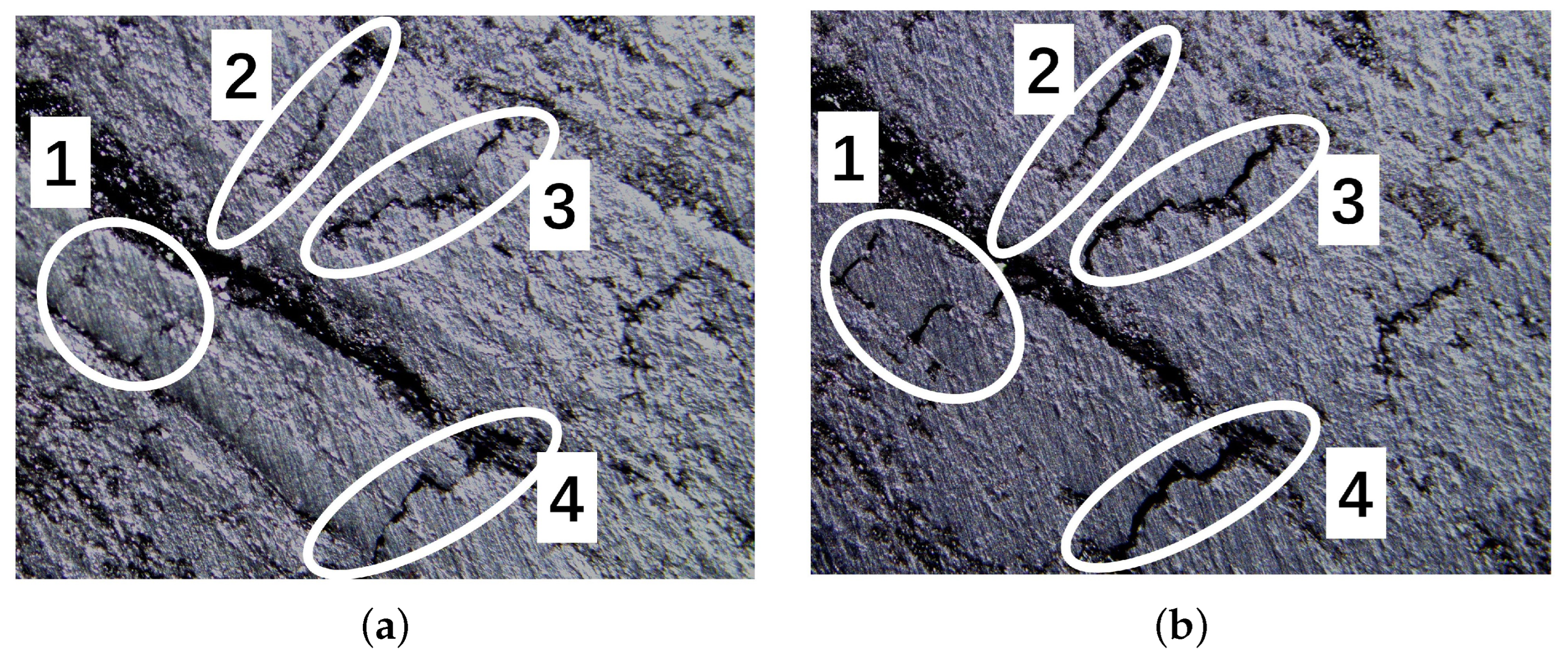

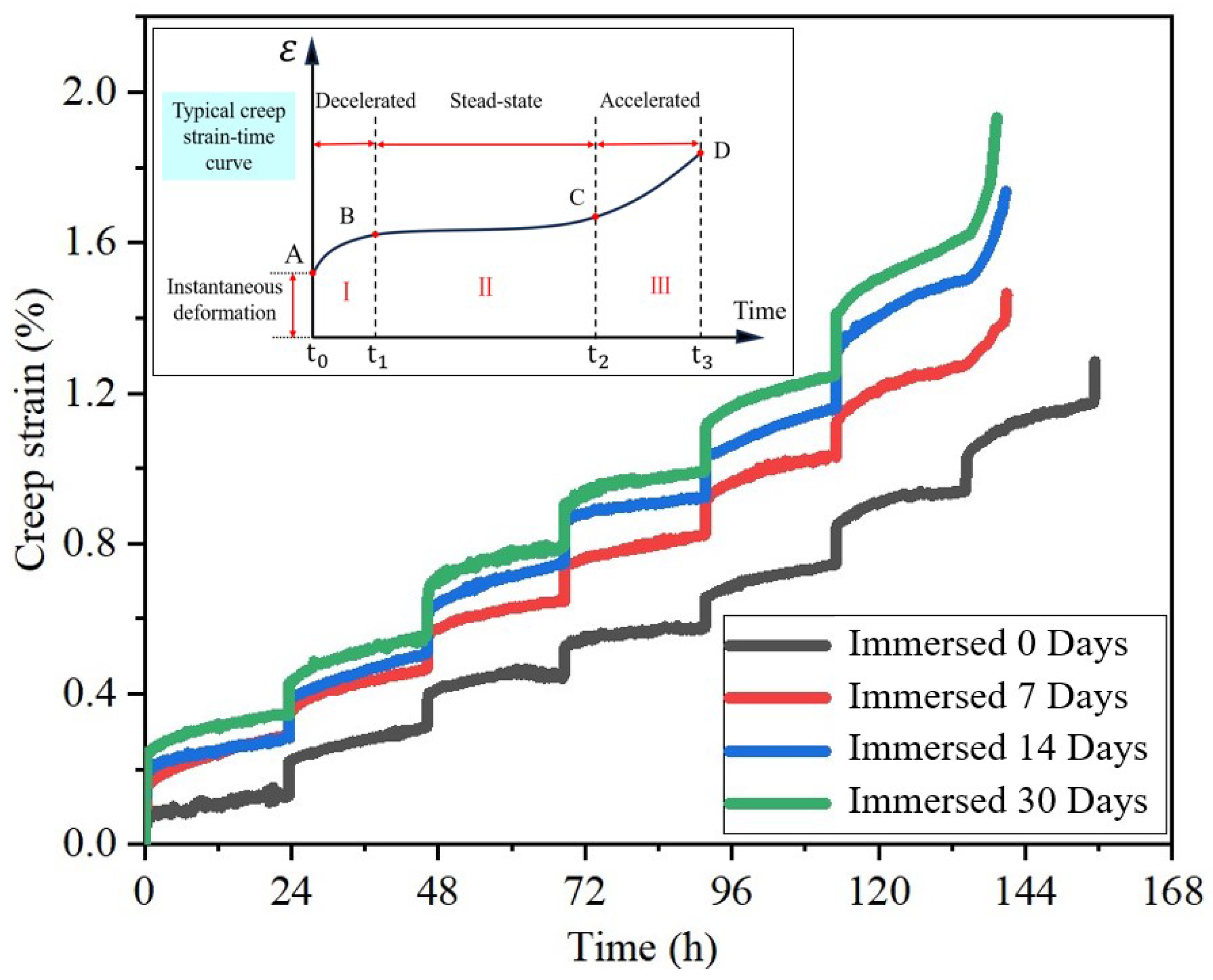

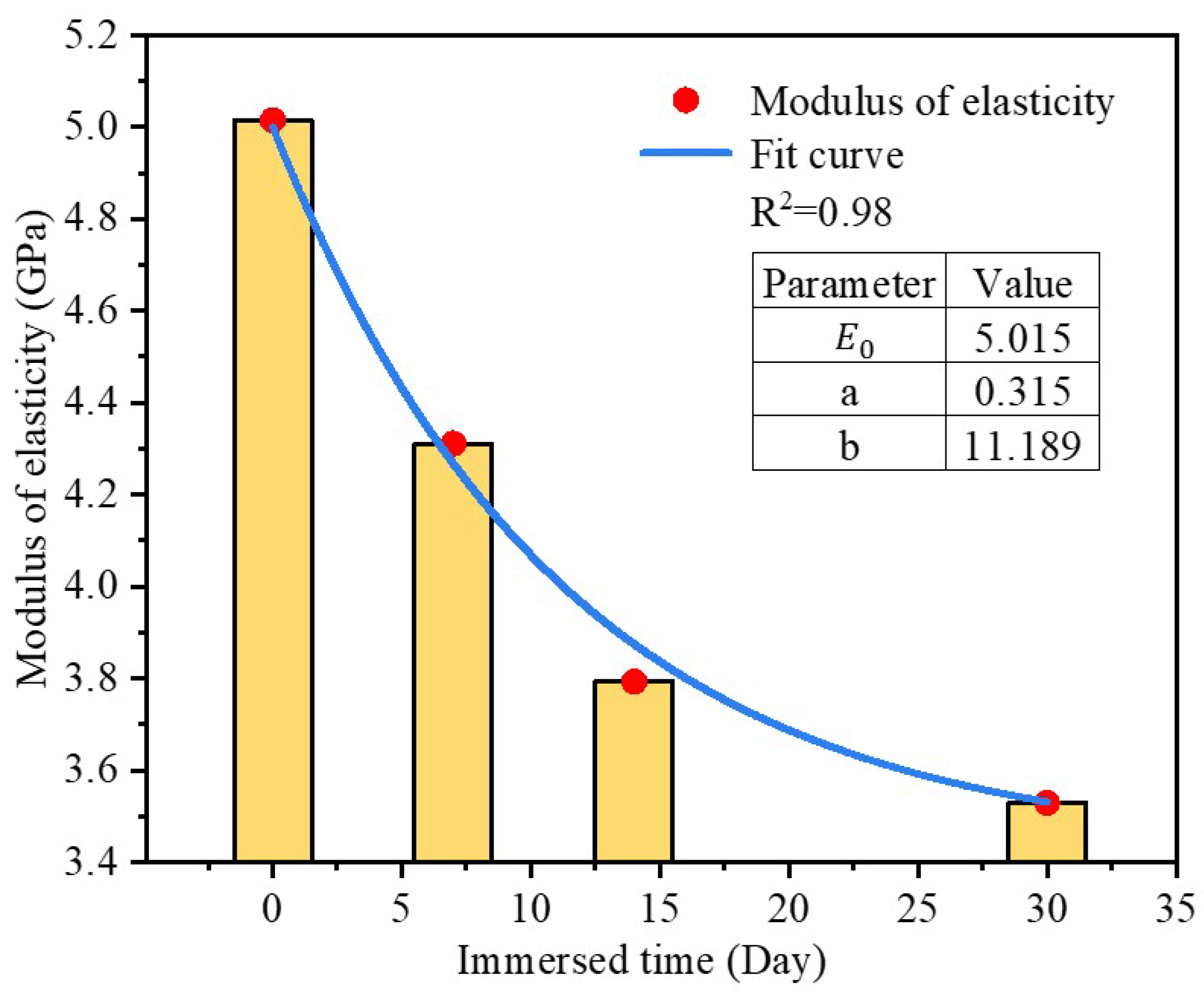


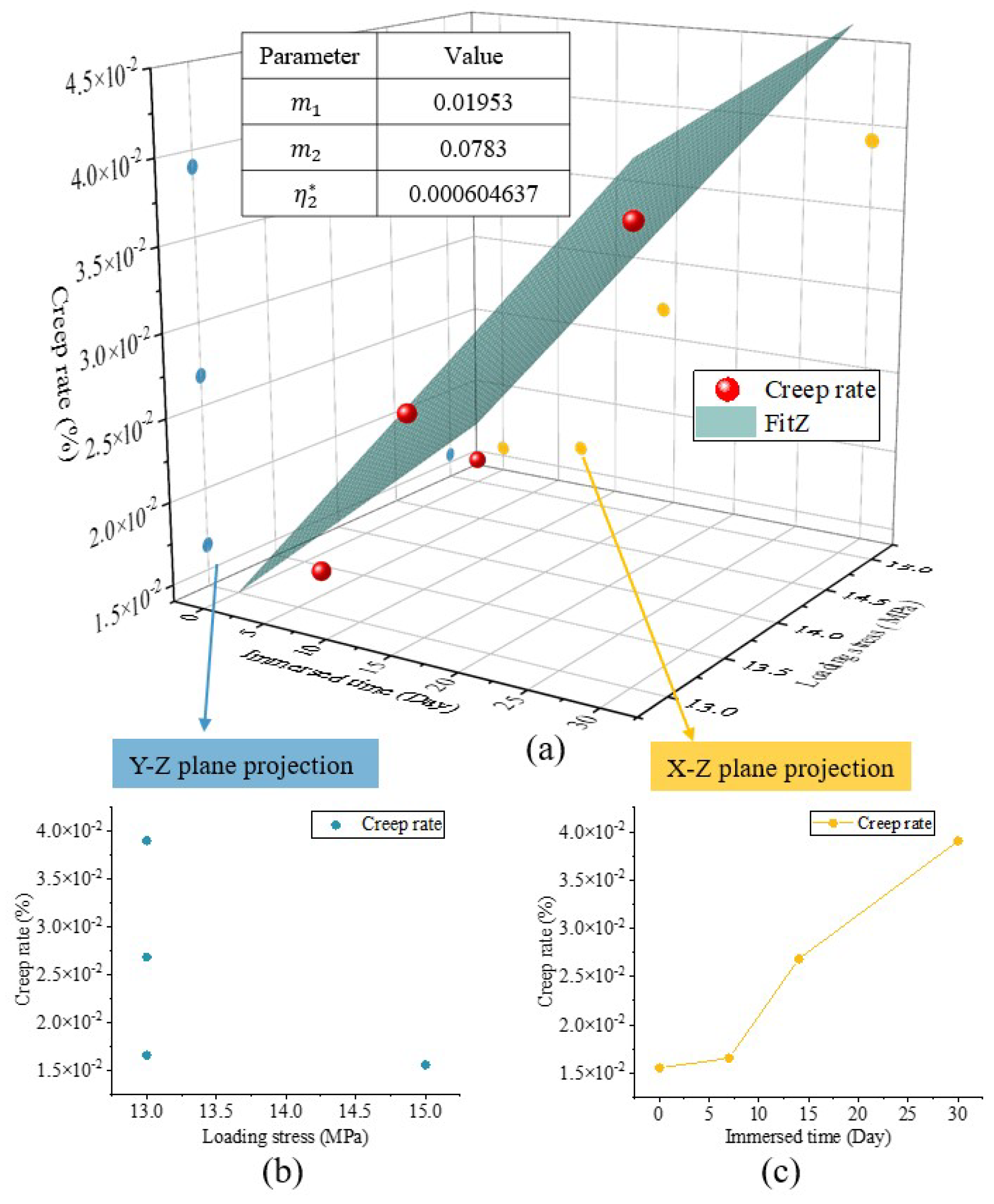
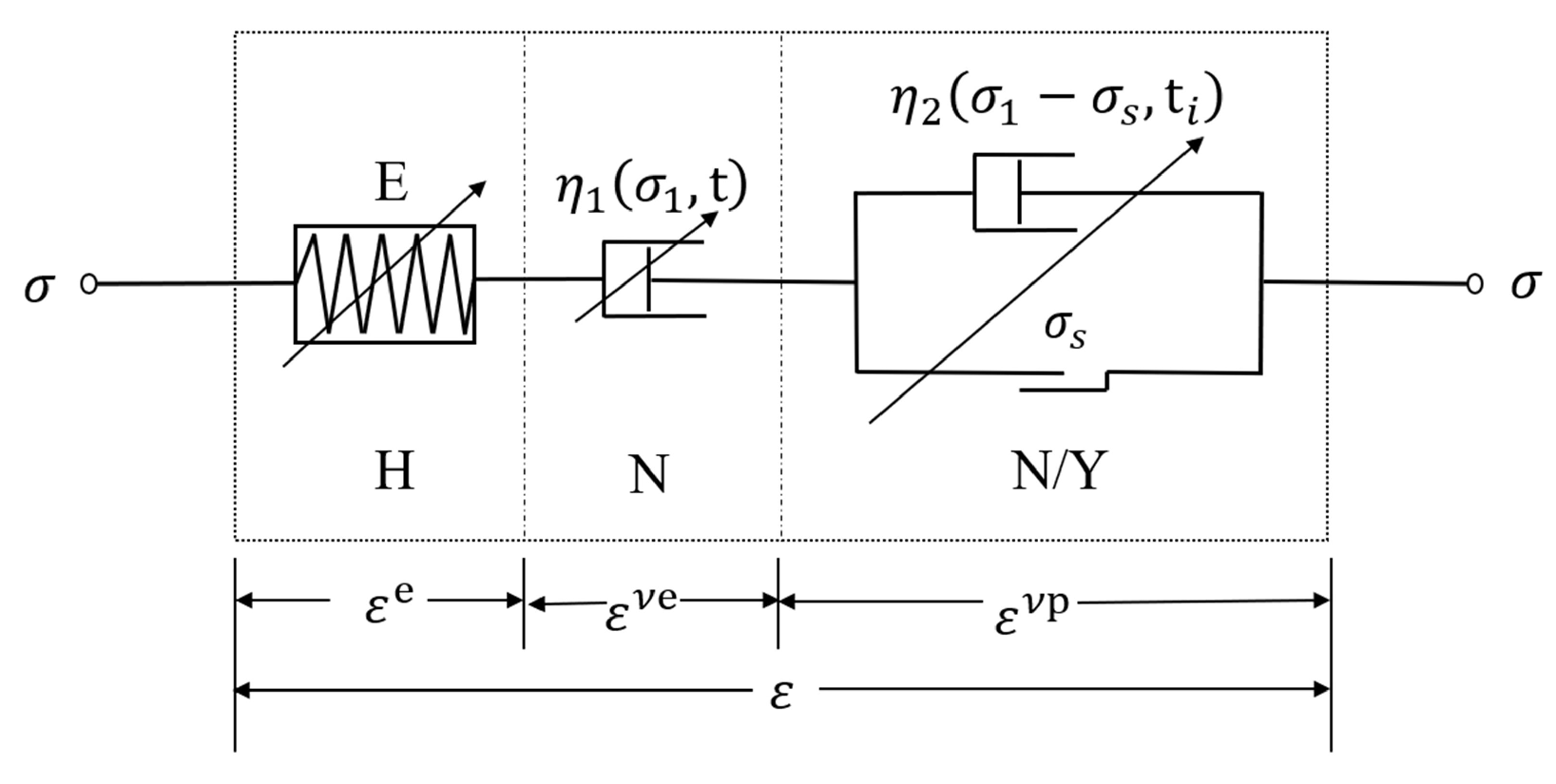

| Parameters | a | b | ||||
| Value | 0.3126 | 11.18947 | 0.0005946 | 0.00978 | 0.00419 | |
| Parameters | c | d | ||||
| Value | 0.000604637 | 0.01953 | 0.0783 | 16.56 | 0.1154 | 8.604 |
| Fitting | ||||||
| Value | 0.85 | 0.86 | 0.83 |
Disclaimer/Publisher’s Note: The statements, opinions and data contained in all publications are solely those of the individual author(s) and contributor(s) and not of MDPI and/or the editor(s). MDPI and/or the editor(s) disclaim responsibility for any injury to people or property resulting from any ideas, methods, instructions or products referred to in the content. |
© 2023 by the authors. Licensee MDPI, Basel, Switzerland. This article is an open access article distributed under the terms and conditions of the Creative Commons Attribution (CC BY) license (https://creativecommons.org/licenses/by/4.0/).
Share and Cite
Li, G.; Wanyan, Q.; Li, Z.; Yi, H.; Ren, F.; Chen, Z.; Liu, Y. A Fractional-Order Creep Model of Water-Immersed Coal. Appl. Sci. 2023, 13, 12839. https://doi.org/10.3390/app132312839
Li G, Wanyan Q, Li Z, Yi H, Ren F, Chen Z, Liu Y. A Fractional-Order Creep Model of Water-Immersed Coal. Applied Sciences. 2023; 13(23):12839. https://doi.org/10.3390/app132312839
Chicago/Turabian StyleLi, Gen, Qiqi Wanyan, Zhengsheng Li, Haiyang Yi, Fengfei Ren, Zheng Chen, and Yang Liu. 2023. "A Fractional-Order Creep Model of Water-Immersed Coal" Applied Sciences 13, no. 23: 12839. https://doi.org/10.3390/app132312839
APA StyleLi, G., Wanyan, Q., Li, Z., Yi, H., Ren, F., Chen, Z., & Liu, Y. (2023). A Fractional-Order Creep Model of Water-Immersed Coal. Applied Sciences, 13(23), 12839. https://doi.org/10.3390/app132312839





